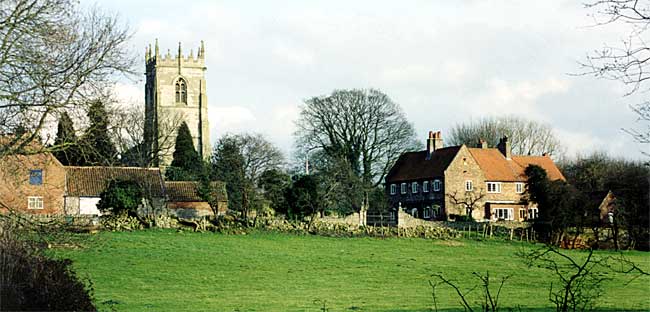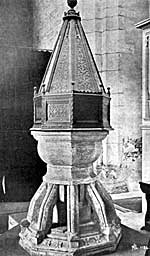
East Markham church and manor house (A Nicholson, 2003).
Turning our attention to the architectural details to the Church, the first object of interest, and, perhaps, I may add, of admiration, is to be found in the clerestory windows. A casual glance may provoke the remark—"Decorated." Nay, good Thoroton pilgrim, Perpendicular, I think. The crenelated capitals and columns of the nave may not meet with the approval of all. Not quite severe enough to suit some, perhaps, but evidencing a desire to embellish and finish the stonework, so as to bring it more into harmony with the richness of painted glass and screen work, which, no doubt, were here in the 15th century. The chancel roof is much lower than that of the nave, and, until its restoration by Mr. Oldrid Scott some twenty years ago, was of the same height throughout. The easternmost boss of the roof, therefore, was previously below the top of the window. Standing against the north wall of the chancel is the tomb of Judge Markham. Throsby in 1797 conjectured that it formerly stood in the centre of the chancel, but Sir Robert Markham, of Sedgebrook, writing in A.D. 1680 says it was in its present position when he visited the church. It is certainly in the right position for being used for the Easter sepulchre, and, judging from the position of other founders' tombs, may have been placed there for the purpose. Sir Clements Markham, the well known president of the Royal Geographical Society, writing in 1882, describes the tomb as having one slab broken, but it was restored soon after with funds left for the purpose by the daughters of Archbishop Markham (A.D. 1777). I have been told that some pieces of stained glass and fragments of alabaster were found in the tomb at its restoration. The inscription on the top of the tomb is as follows:—"Orate pro anima Johis Markham iusticiarii qui obiit in festo Sci Silvestri (papae) anno dni millia CCCC nono cuiiis anime propitietur Deus. Amen." The word "papae" has been nearly cut out, not by the spoilers of our churches in the 16th and 17th centuries, but by vandals of the 18th and 19th centuries, for George Markham in A.D. 1784 said it was plainly legible then. Among a number of local names, records of ignorance and irreverence, scratched on the soft alabaster, appear those of John Clarke and William Monk, 1647. A mural tablet designed in the Gothic of the period, to the memory of Sherard Becher, Vicar of East Markham for 41 years, is in the south wall of the chancel. It also contains stones to the memory of members of the Williamson family, which succeeded that of Markham; and of the Kirkes, who have been identified with the place since A.D. 1681. At the entrance to the chancel is a stone inscribed with the name of "The Reverend William Che(a)les, 34 years Vicer (sic) of this parish." The spelling leaves something to be desired. Since this gentleman was instituted in 1777 only three institutions have taken place, Mr. Becher in 1811, Mr. Brameld in 1852, and the present vicar in 1896. The east window was filled with stained glass in 1897 in memory of the late vicar, and was designed and executed by Mr. J. N. Comper. In the nave, attention may be directed (1) to the rood staircase, bricked up and used as a chimney in the early part of the last century; (2) the brass of Dame Milicent Meryng, to whom I have before alluded as the second wife of Judge Markham; she died, as the inscription relates, on September 27th, A.D. 1419. This brass was originally on the top of an altar tomb, some stones belonging to it being now near the porch. (3) The screen, apparently cut down and altered to meet the Caroline requirements in Laudian days, was removed to its present position in 1897 to make way for a proposed screen and loft, promised to the church by the present Duke of Newcastle; (4) the windows in the south aisle have in their top lights fragments of painted glass removed from different parts of the church in 1883-4.

Font, East Markham church.
During the preceding eighty odd years a considerable quantity of painted glass appears to have been removed. St. Lo Kniveton mentions for instance certain pieces which have disappeared since he wrote, as for instance those of Foljambe, Longvilliers, and Markham. At the present time there are in the east window of the south aisle three old shields and a modern one; the last is that of Markham. Of the old shields, that in the left-hand light is—sable, a chevron erm, between three estoiles arg. I am informed by Mr. George Fellows that these are the arms of Bewster or Brewster of Suffolk, The shield was removed, I believe, from a window which contained also the arms of Cressy. In the centre light there is a shield, azure, bearing three chevronels interlaced in base or, a chief or. The same authority gives this shield as Fitz-Hugh. The right hand light bears—Arg., three palmers staves (should be gules) which are recognised as Burdon by St. Lo Kniveton, impaling cheq. arg, and gules, a bend sab, Bekeryng. This shows that Milicent, second wife of Judge Markham, was a Bekeryng. One of the windows in the south aisle was restored in memory of Mrs. Penrose, authoress of "Mrs. Markham's History of England." This lady took her nom de plume from the village where she spent her early years under the guardianship of her aunts, the Misses Cartwright, who for a time owned the Hall, known then as Mirfleld Hall to distinguish it from an ancient house in the village known as the "Old Hall." Mrs. Penrose's father was Dr. Edmund Cartwright, inventor of the power loom in A.D. 1785. An old poor box, with the inscription, "Remember the Poore," stands near the south door. The litany desk was made from an old bench-end found under the floor. The font is an interesting piece of work, probably dating from 1686, except for its 14th century base. In that year a somewhat extensive restoration must have taken place, as until 1883 most of the pews were of that date, two ends of these forming the present credence. The altar rails, pulpit, and font cover belong also to the same period. In the north aisle there is an old altar slab, which between the periods of desecration and restoration, formed a paving stone at the entrance to the chancel. At least two of the crosses on it are quite visible, although much worn. Passing to the outside of the church, a figure will be noticed on the south side of the tower—local tradition calls it Judge Markham, perhaps not realising that its date is anterior to that of the judge. It is more probably the image of St. John the Baptist, patron of the church. The dedication may possibly be connected with Rouen, the arms of that city having the Agnus Dei in chief. There is a sundial without its gnomon, and a piece of moulding built into the wall of the south aisle. The gargoyles are somewhat elaborate in contrast with the extremely plain character of the chancel windows, over which they grin and smirk and scowl. The bells are six in number, four are dated 1637, the other two 1895. The parish registers date from 1561, the vestry book from 1662. Among the entries in the latter is one stating that a vestry meeting was held "in the chancel on Sunday, May 29th, 1785." Another that "Elizabeth Billiald being excommunicated was absolved May 3rd, 1704." A third that on "October 30th, 1695, King William III. came from Lincoln, through Great Markham, in his progress to Welbeck" to visit the first Duke of Newcastle. From the list of "Testamentary Burialls" in the Torre MS. I cull the following:—" 15th November, 1432. Hugh Knyght, Vicar, to be buried in the church. 30th April, 1439; Christopher Saureby, Vicar, to be buried before the chancel door. 14th October, 1446; Robt. Markham, of East Markham, to be buried in the church before S. Trinity's Altar. 31st October, 1548; Robt. Robotham, Vicar, to be buried in the High Quire." For the sake of students of domestic life in past years let me give an extract from a petition by Thomas Gylby, Vicar, to Lancelot Archbishop of York, 1738, which sets forth that "The Vicarage house of East Markham, through the length of time since it was first built, is become very bad and ruinous, and besides so inconvenient as to have cattle go to water and pasture through the midst of the house." Of traditions connected with the village I will give the most authentic first. In 1609 a plague broke out in Markham, which devastated the village and caused its market to he removed to the neighbouring town of Tuxford. During the year there were 115 deaths in the village, the last being that of the vicar, William Field. The town of Markham, however, for it is called in local phraseology a town, did not then altogether lose its prestige, for I have been told by people whose informants could remember the fact, that not so many years ago a row of six or seven carriages of the "quality," whose owners were making their purchases at the local shop, might be seen constantly outside the present post office. A less savoury tradition is that of a former vicar who, being nonresident, rode over on Sunday morning, find putting tip at an inn close to the church, sent the clerk backwards and forwards to the church, in order that he might have "another pot" before an expectant congregation assembled. I have been informed, moreover, that after waiting for several pots, and hearing that no one had "coom," he would remount and ride away. There is, of course, the usual tradition of Cromwell's soldiers stabling their horses in the church. It is more probable that the havoc committed is to be laid partly at the doors of those so-called custodians of the church in the 18th and early 19th centuries, who allowed glaziers from Tuxford to remove stained glass and replace it with "nice clean" white glass, and also at the doors of Cromwell's namesake in in the 16th century, the list of whose depredations would probably reveal how much of the glory of Markham is departed. Something of his work on behalf of his master, Henry VIII., may be learnt by a perusal of the following list of church goods apparently left by him but removed in the sixth year of Edward VI.:—One chalesse of sylvr pcell gilte, one crosse bullion single gylte, one vestment of changeable sylke wt albes and amysses for deacon and sbdeacon of the same coler, one vestment of dornix wt the albe and amysse yrto, one old vestment of grene and yallow sylke. wt the albe and amysse yrto, one cope of grene velvet inbrowdered, one cope of changeable sylke, one cope of dormix, three bells in the stepull, one hand bell wt a little sacringe bell, In conclusion it seems to me that one of the greatest boons to present and future generations, which a society like the Thoroton can give, is the increased interest in and study of our village churches, which must be the result of such excursions on which you are engaged. I do not think the vandalism of the past would have been possible if those custodians of the churches who so shamefully neglected their duty had known that periodically they would receive a visit from those who, at least, took an artistic and antiquarian interest in every stone, every quarry of glass, and every ornament or piece of furniture in the building.
